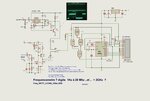Mohamed Slama
Member level 4
Hi
I have done 50 MHZ frequency counter by pic 16f877A and 20MHZ crystal.
My question : can i convert it to 200 MHZ by divide the input frequency to a certin value ??
If yes , any another steps are required ?
thank u in advance
I have done 50 MHZ frequency counter by pic 16f877A and 20MHZ crystal.
My question : can i convert it to 200 MHZ by divide the input frequency to a certin value ??
If yes , any another steps are required ?
thank u in advance
